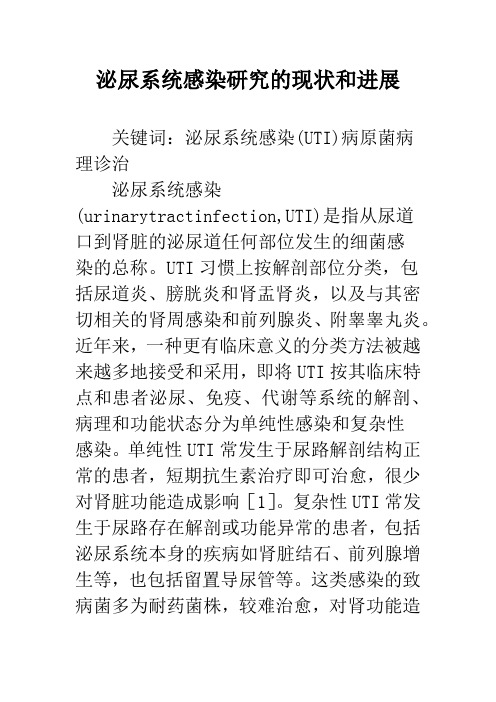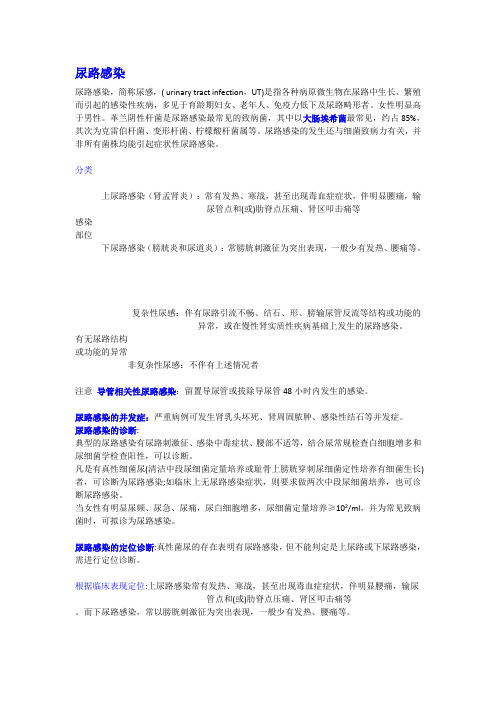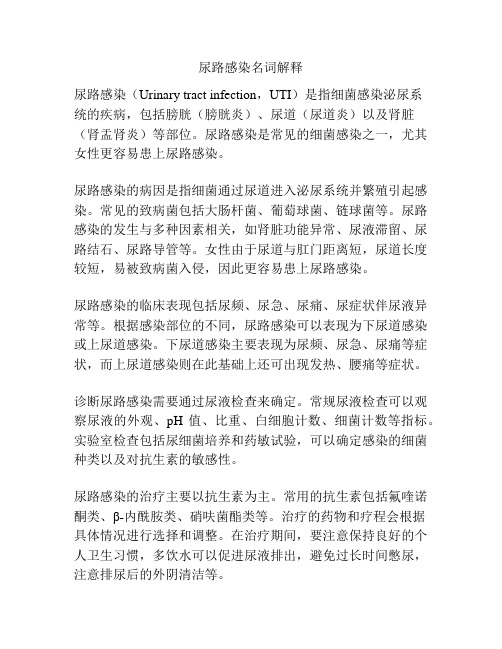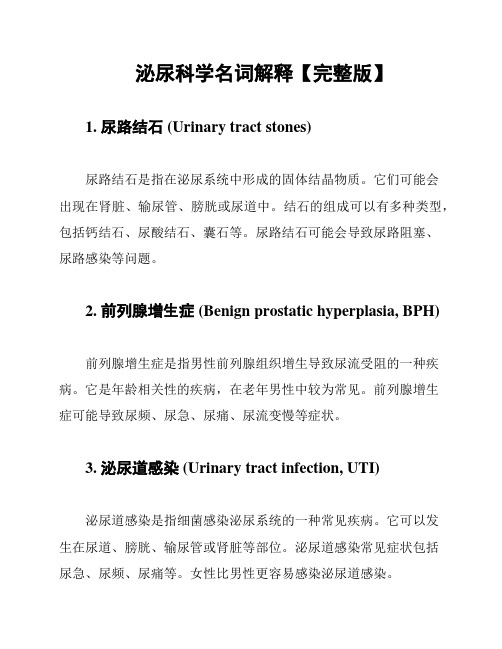UrinaryTractInfection(尿路感染全英文)
内科学英文课件:Urinary tract infection尿路感染

8
Host genetic factors
Host genetic factors influence susceptibility to UTI
women who have experienced recurrent UTIs the number and type of receptors on uroepithelial cells
6
Bacterial Virulence Factors
Infecting organisms have a variable capacity to stimulate or evade activation of the immune response.
✓ Uropathogenic produce hemolysin (溶血素) and aerobactin (菌素)
Host
• Obstruction • Gender and Sexual activity • Pregnancy • Neurogenic Bladder Dysfunction • Vesicoureteral Reflux
5
Pathogen
Gram-negative organisms is most common 95%
✓ Fimbriae(菌毛) :I,P,S ✓ Specific O,K and H serogroups.
Escherichia coli 大肠杆菌
7
Host defenses of the normal urinary tract
Valve at the junction of ureter and bladder.
uti的分类

uti的分类一、上尿路感染(Upper urinary tract infection,UTI)上尿路感染是指细菌感染泌尿系统的上部,包括肾脏和输尿管。
常见症状包括发热、肾区疼痛、尿频、尿急等。
上尿路感染常由尿路结石、泌尿系解剖异常、尿液潴留等因素引起。
治疗一般采用抗生素,如青霉素类药物或氟喹诺酮类药物。
二、下尿路感染(Lower urinary tract infection,UTI)下尿路感染是指细菌感染泌尿系统的下部,包括膀胱、尿道和尿道口。
常见症状包括尿频、尿急、尿痛等。
下尿路感染多由肠道细菌进入尿道引起,女性更容易患上下尿路感染。
治疗一般采用口服抗生素,如硝基呋喃类药物或氟喹诺酮类药物。
三、复发性尿路感染(Recurrent urinary tract infection,RUTI)复发性尿路感染指尿路感染反复发作或频繁发作。
一般定义为每年发作两次或更多。
复发性尿路感染可能与感染的细菌种类、尿路解剖结构异常、免疫功能异常等因素有关。
治疗一般包括预防性使用抗生素、尿路感染健康教育等措施。
四、尿路结石相关尿路感染(Urinary tract infection associated with urinary stones)尿路结石是指在泌尿系统中形成的结石。
尿路结石可引起尿路梗阻或刺激尿路黏膜,增加尿路感染的风险。
尿路结石相关尿路感染的治疗一般包括解除尿路梗阻、抗生素治疗以及结石治疗。
五、妊娠期尿路感染(Urinary tract infection in pregnancy)妊娠期尿路感染是指孕妇患上的尿路感染。
由于妊娠期间孕妇的免疫系统发生变化,尿路感染的风险增加。
妊娠期尿路感染需要及时治疗,以避免对母婴的不良影响。
治疗一般采用安全有效的抗生素,如青霉素类药物。
六、医院获得性尿路感染(Hospital-acquired urinary tract infection,HA-UTI)医院获得性尿路感染是指患者在住院期间感染的尿路感染。
泌尿系统感染研究的现状和进展

泌尿系统感染研究的现状和进展关键词:泌尿系统感染(UTI)病原菌病理诊治泌尿系统感染(urinarytractinfection,UTI)是指从尿道口到肾脏的泌尿道任何部位发生的细菌感染的总称。
UTI习惯上按解剖部位分类,包括尿道炎、膀胱炎和肾盂肾炎,以及与其密切相关的肾周感染和前列腺炎、附睾睾丸炎。
近年来,一种更有临床意义的分类方法被越来越多地接受和采用,即将UTI按其临床特点和患者泌尿、免疫、代谢等系统的解剖、病理和功能状态分为单纯性感染和复杂性感染。
单纯性UTI常发生于尿路解剖结构正常的患者,短期抗生素治疗即可治愈,很少对肾脏功能造成影响[1]。
复杂性UTI常发生于尿路存在解剖或功能异常的患者,包括泌尿系统本身的疾病如肾脏结石、前列腺增生等,也包括留置导尿管等。
这类感染的致病菌多为耐药菌株,较难治愈,对肾功能造成长时间损害的危险性也明显增加[2]。
正常情况下尿液是无菌的。
然而,这并非意味着所有出现在尿液中的细菌都是致病菌,象乳酸杆菌、甲型溶血链球菌或厌氧菌等因难以在尿液中生长,当其在尿标本中被检出时,一般认为是污染所致。
只有当尿液中检出的菌株可以在泌尿道中生长繁殖,并引起感染时才可确定为泌尿系感染的病原菌。
尿路病原菌具有侵袭力,可以侵入和定植于尿路上皮,并在尿液中繁殖。
一、流行病学尿路感染非常多见。
在不同年龄组的人群中,UTI的发生率不同[3-5]。
新生儿中男童多见,行包皮环切可显着降低感染率。
青少年和成年人群中女性的感染率远远高于男性。
在女性,年龄每增加10岁,感染率便增加1%,至65岁时达10%。
有50%的女性一生中有至少一次尿路感染。
在老年人群中,无论男性和女性,尿路感染都是一个重要问题。
老年患者泌尿道疾病发生率增加,导致复杂性UTI增加。
老年患者菌血症的最常见原发病灶是尿路感染。
除年龄之外,还有一些因素与尿路感染有关[6]。
对一组性活跃期女性的前瞻性研究表明,UTI的危险性与近期使用含杀精子药物的阴道隔膜,性生活,以及既往有UTI 病史有关。
尿路感染笔记 全面

尿路感染尿路感染,简称尿感,( urinary tract infection,UT)是指各种病原微生物在尿路中生长、繁殖而引起的感染性疾病,多见于育龄期妇女、老年人、免疫力低下及尿路畸形者。
女性明显高于男性。
革兰阴性杆菌是尿路感染最常见的致病菌,其中以大肠埃希菌最常见,约占85%,其次为克雷伯杆菌、变形杆菌、柠檬酸杆菌属等。
尿路感染的发生还与细菌致病力有关,并非所有菌株均能引起症状性尿路感染。
分类上尿路感染(肾孟肾炎):常有发热、寒战,甚至出现毒血症症状,伴明显腰痛,输尿管点和(或)肋脊点压痛、肾区叩击痛等感染部位下尿路感染(膀胱炎和尿道炎):常膀胱刺激征为突出表现,一般少有发热、腰痛等。
复杂性尿感:伴有尿路引流不畅、结石、形、膀输尿管反流等结构或功能的异常,或在慢性肾实质性疾病基础上发生的尿路感染。
有无尿路结构或功能的异常非复杂性尿感:不伴有上述情况者注意导管相关性尿路感染:留置导尿管或拔除导尿管48小时内发生的感染。
尿路感染的并发症:严重病例可发生肾乳头坏死、肾周固脓肿、感染性结石等并发症。
尿路感染的诊断:典型的尿路感染有尿路刺激征、感染中毒症状、腰部不适等,结合尿常规检查白细胞增多和尿细菌学检查阳性,可以诊断。
凡是有真性细菌尿(清洁中段尿细菌定量培养或耻骨上膀胱穿刺尿细菌定性培养有细菌生长)者,可诊断为尿路感染;如临床上无尿路感染症状,则要求做两次中段尿细菌培养,也可诊断尿路感染。
当女性有明显尿频、尿急、尿痛,尿白细胞增多,尿细菌定量培养≥102/ml,并为常见致病菌时,可拟诊为尿路感染。
尿路感染的定位诊断:真性菌尿的存在表明有尿路感染,但不能判定是上尿路或下尿路感染,需进行定位诊断。
根据临床表现定位:上尿路感染常有发热、寒战,甚至出现毒血症症状,伴明显腰痛,输尿管点和(或)肋脊点压痛、肾区叩击痛等。
而下尿路感染,常以膀胱刺激征为突出表现,一般少有发热、腰痛等。
根据实验室检查定位:出现下列情况提示上尿路感染:①膀胱冲洗后尿培养阳性;2)尿沉渣镜检有白细胞管型,并排除间质性肾炎、狼疮性肾炎等疾病;③尿NAG升高、尿β2:MG升高④尿渗透压降低。
uti标准

UTI标准是指尿路感染(Urinary Tract Infection,简称UTI)的诊断和治疗的一套规范和准则。
UTI是一种常见的感染性疾病,主要发生在泌尿系统中的膀胱、尿道、输尿管和肾脏等部位。
本文将从定义、病因、临床表现、诊断和治疗等方面详细介绍UTI标准。
一、定义UTI是指细菌或其他病原体感染泌尿系统的疾病,包括下尿路感染和上尿路感染。
下尿路感染主要指膀胱和尿道感染,上尿路感染主要指输尿管和肾脏感染。
二、病因1. 细菌感染:大多数UTI由细菌引起,常见的致病菌包括大肠杆菌、金黄色葡萄球菌等。
2. 高危因素:女性更容易患UTI,因为她们的尿道较短,而且靠近肛门,易受细菌感染。
其他高危因素包括妊娠、年龄、性行为等。
3. 尿路畸形:尿路结构异常、尿路梗阻等情况增加了UTI的发生风险。
三、临床表现1. 下尿路感染:包括尿频、尿急、尿痛、尿道灼热感、膀胱部位不适等症状。
常见的病原体是大肠杆菌。
2. 上尿路感染:除下尿路感染症状外,还可伴有发热、腰痛、恶心、呕吐等症状。
常见的病原体是肾脏感染的细菌。
四、诊断1. 病史询问:询问患者的症状、既往病史、用药史等。
2. 体格检查:包括腹部触诊、肾区叩击痛、尿道口红肿等。
3. 实验室检查:尿常规、尿培养和药敏试验是诊断UTI的关键。
尿常规可检测尿液中白细胞、红细胞、细菌等指标。
尿培养可确定致病菌种类,并进行药敏试验选择合适的抗生素治疗。
五、治疗1. 抗生素治疗:根据尿培养和药敏试验结果选择敏感的抗生素进行治疗。
一般情况下,治疗时间为7-14天。
2. 对症治疗:包括解热镇痛药物、增加水分摄入、注意个人卫生等。
3. 预防复发:饮食均衡、避免憋尿、保持私处清洁、多喝水等措施可以预防UTI的复发。
六、如何避免UTI的发生1. 注意个人卫生:保持外阴清洁,每天使用温水清洗外阴,避免使用过于刺激性的洗液。
2. 多喝水:多饮水可以增加尿液排出,有助于冲洗尿路,减少细菌滋生的机会。
5.尿路感染

主要内容
病因 发病机制
并发症 实验室和其他检查
流行病学
病理解剖 临床表现
诊断及鉴别诊断
治疗 预防
病因
病原体:包括细菌、结核杆菌、衣原体、真菌等。 最常见的为革兰氏阴性杆菌,其中大肠埃希菌约 占85%;其次是变形杆菌、肺炎克雷伯杆菌、铜
绿假单胞菌等;少数(5-15%)为革兰氏阳性球
主要内容
病因 发病机制
行性肾盂造影等。
排查尿路结石、梗阻、反流、畸形等导致尿路感染反复 发作的因素。
尿路感染急性期不宜做IVP ,可做B超检查。
主要内容
病因 发病机制
并发症 实验室和其他检查
流行病学
病理解剖 临床表现
诊断及鉴别诊断
治疗 预防
诊断和鉴别诊断
尿路感染的诊断流程
1.确诊尿路感染的存在
尿细菌学检查
细菌学检查的假阳性和假阴性
假阳性:①标本收集时,白带污染;②标本在室温放置 >1h;③接种和检查的技术有误。 假阴性:①近7天内用药;②尿液停留<6h;③标本收 集时,消毒液混入尿标本;④饮水过多,尿液被稀释; ⑤感染灶排菌呈间歇性。
涂片细菌检查
采用新鲜中段非离心尿革兰染色后油镜观察,≥1个菌/视野,尿 路感染诊断的阳性率90%;≥5个菌/视野,则可达99%。该方法 简便易行,可初步确定细菌种类,对选择治疗方案具有一定指导 意义。但未检测到细菌也不能排除尿路感染的诊断。
尿细菌学检查
以真性细菌尿为准绳。
清洁中段尿细菌定量培养≥105/ml为阳性(真性
尿路感染名词解释

尿路感染名词解释尿路感染(Urinary tract infection,UTI)是指细菌感染泌尿系统的疾病,包括膀胱(膀胱炎)、尿道(尿道炎)以及肾脏(肾盂肾炎)等部位。
尿路感染是常见的细菌感染之一,尤其女性更容易患上尿路感染。
尿路感染的病因是指细菌通过尿道进入泌尿系统并繁殖引起感染。
常见的致病菌包括大肠杆菌、葡萄球菌、链球菌等。
尿路感染的发生与多种因素相关,如肾脏功能异常、尿液滞留、尿路结石、尿路导管等。
女性由于尿道与肛门距离短,尿道长度较短,易被致病菌入侵,因此更容易患上尿路感染。
尿路感染的临床表现包括尿频、尿急、尿痛、尿症状伴尿液异常等。
根据感染部位的不同,尿路感染可以表现为下尿道感染或上尿道感染。
下尿道感染主要表现为尿频、尿急、尿痛等症状,而上尿道感染则在此基础上还可出现发热、腰痛等症状。
诊断尿路感染需要通过尿液检查来确定。
常规尿液检查可以观察尿液的外观、pH值、比重、白细胞计数、细菌计数等指标。
实验室检查包括尿细菌培养和药敏试验,可以确定感染的细菌种类以及对抗生素的敏感性。
尿路感染的治疗主要以抗生素为主。
常用的抗生素包括氟喹诺酮类、β-内酰胺类、硝呋菌酯类等。
治疗的药物和疗程会根据具体情况进行选择和调整。
在治疗期间,要注意保持良好的个人卫生习惯,多饮水可以促进尿液排出,避免过长时间憋尿,注意排尿后的外阴清洁等。
预防尿路感染的关键在于保持良好的个人卫生习惯。
常见的预防措施包括:1. 多饮水,多排尿,使尿液稀释,使细菌不易附着在尿道上;2. 尽量避免憋尿,定时排尿,减少细菌滞留在尿道的机会;3. 使用适当的卫生用品,如未用过的卫生纸、卫生湿巾等;4. 注意外阴清洁,每天清洗外阴并保持干燥;5. 尿道保健,尽量避免使用刺激性的护理用品和避免过度清洁。
尿路感染是一种常见的泌尿系统感染,临床诊断主要通过尿液检查,治疗以抗生素为主,预防重在个人卫生的维护。
及时发现和治疗尿路感染是预防其进一步发展为肾脏感染等严重并发症的关键。
Urinary Tract Infection(尿路感染全英文)_图文

Definition of UTI
UTI is defined as the presence of microorganisms in the urinary tract.
Most patients with UTI have significant bacteriuria, i.e. bacterial colony counts ˃ 105 /ml, in a mid-stream “clean catch” urine.
CASE 2 65 year-old woman; Dysuria and frequency; Pyuria; Gram positive cocci. Enterococcus faecalis
CASE 3 18 year-old woman Dysuria and frequency; Pyuria; Gram positive cocci; Staphylococcus.
2. Regular urine flow: dilute and expel pathogens
3. Bladder epithelial cells: coated with mucus (glycosaminoglycan) prevent bacteria from adhering to bladder wall
尿路感染UrinaryTractInfection

2019/10/16
承德市第五医院 张德蕴
UTI的致病菌临床特点(2)
器械操作相关:
绿脓杆菌
尿路结石:
变形杆菌
血源性感染:
金黄色葡萄球菌
长期使用抗生素、免疫抑
制剂或糖尿病患者: 念珠菌、酵母菌
性活动相关:
衣原体、淋球菌
其它:
滴虫、丝虫、阿米巴、病毒
2019/10/16
女学生 发生率1.2%
男学生 发生率0.03-0.04%
2019/10/16
承德市第五医院 张德蕴
UTI的流行病学资料(2)
婚姻状态:未婚女性 已婚女性
60岁以上 女性 男性
50岁以上 男性
发病率为7.2% 发病率为5% 发生率为10-12% 低于女性1:8 发生率增加为7%
2019/10/16
敏感菌感染
建议长疗程低 剂量预防治疗
短程敏感 抗生素
有效
6周大剂量 抗生素治疗
无效
UTI的治疗
感染
非复杂性膀胱炎 膀胱炎
急性肾盂肾炎
复杂性感染
人群
药物
年轻女性
磺胺类、喹诺酮类
糖尿病、反复发作、 同上、头孢菌素及
有症状者、>65岁 呋喃坦叮
妊娠妇女
阿莫西林、头孢菌
素、磺胺类
门诊女性
喹诺酮类、头孢
菌素、磺胺类
93%敏感率
阳性 可疑 正常
2019/10/16
承德市第五医院 张德蕴
急性肾盂肾炎并发症
肾功能轻度受损 菌血症导致感染性休克 DIC,ARDS 肾乳头坏死、肾脓肿、肾周脓肿(DM)
需影像学检查证实
2019/10/16
尿路感染PPT课件

2、反复发作性膀胱炎
主要源于重新感染,少数为复发
一般在停药后6周或在细菌学及尿液检查持续阴性3 周后发生的感染支持重新感染
复发是指治疗后细菌消失,但停药6周内复发,且致 病菌与上次相同
13
3、急性单纯性肾盂肾炎
全身表现:畏寒、发热,可伴恶心、呕吐
泌尿系统症状:尿路刺激征、腰痛、肾区叩痛、输 尿管走行的体表部位及膀胱区压痛 尿液改变:外观浑浊,呈脓尿或血尿 常见致病菌:大肠杆菌、变形杆菌、克雷白杆菌
25
(3)治疗反应差
上尿路感染的支持点
患者全身感染性症状较明显 膀胱冲洗后尿培养有细菌生长
尿中有白细胞管型
尿β2微球蛋白增多,血β2微球蛋白降低
致病菌为少见致病菌
复杂性尿感 治疗后复发,单剂抗菌治疗无效
26ห้องสมุดไป่ตู้
鉴别诊断
尿道综合征:尿道刺激症,尿细菌培养(-) (1)感染性: 依原体和支原体,性病 (2)非感染性: 病原体(-),焦虑症 肾结核:膀胱刺激征明显,持久 抗酸杆菌(+) OT,PPD试验(+) 一般抗菌无效 X线:肾实质虫蚀样缺损 输尿管串珠状改变
尿路感染
(Urinary tract infection)
1
概述
尿路感染(urinary tract infection,
UTI)通常是指由细菌、病菌等病源微生 物直接侵袭尿路引起的非特异性感染。 可分为上尿路感染(主要是肾盂肾炎)和 下尿路感染(膀胱炎、尿道炎)
2
上 尿 路
下 尿 路
性别: 女性 > 男性 (10 : 1) 好发年龄: 育龄,老年,婴幼儿 分类: 上尿路感染,下尿路感染 急性,慢性 复杂性,非复杂性 细菌性,真菌性(极少见)
泌尿科学名词解释【完整版】

泌尿科学名词解释【完整版】1. 尿路结石 (Urinary tract stones)尿路结石是指在泌尿系统中形成的固体结晶物质。
它们可能会出现在肾脏、输尿管、膀胱或尿道中。
结石的组成可以有多种类型,包括钙结石、尿酸结石、囊石等。
尿路结石可能会导致尿路阻塞、尿路感染等问题。
2. 前列腺增生症 (Benign prostatic hyperplasia, BPH)前列腺增生症是指男性前列腺组织增生导致尿流受阻的一种疾病。
它是年龄相关性的疾病,在老年男性中较为常见。
前列腺增生症可能导致尿频、尿急、尿痛、尿流变慢等症状。
3. 泌尿道感染 (Urinary tract infection, UTI)泌尿道感染是指细菌感染泌尿系统的一种常见疾病。
它可以发生在尿道、膀胱、输尿管或肾脏等部位。
泌尿道感染常见症状包括尿急、尿频、尿痛等。
女性比男性更容易感染泌尿道感染。
4. 尿失禁 (Urinary incontinence)尿失禁是指无法控制尿液排出的情况。
它可能导致尿液意外流失,给患者带来不便和困扰。
尿失禁可以有多种原因,包括肌肉无力、神经功能障碍、尿道梗阻等。
5. 膀胱癌 (Bladder cancer)膀胱癌是指发生在膀胱组织中的恶性肿瘤。
它是泌尿系统中常见的癌症之一。
膀胱癌症状可能包括血尿、尿频、尿急、腰背痛等。
膀胱癌的治疗方法包括手术切除、放疗、化疗等。
6. 障碍 (Ejaculatory disorders)障碍是指男性在性行为中无法正常完成的情况。
它可能表现为延迟、无力、疼痛等。
障碍可能由多种原因引起,包括神经性、心理性以及器质性的因素。
7. 肾移植 (Kidney transplant)肾移植是指将健康的肾脏从一个人体内移植到另一个人体内的手术过程。
肾移植通常用于治疗严重的肾功能衰竭。
在肾移植手术后,接受者需要长期服用免疫抑制药物以防止排斥反应。
8. 尿毒症 (Uremia)尿毒症是一种严重的肾功能衰竭疾病,体内代谢产物无法通过正常的排尿途径排出而积累在体内。
尿路感染urinarytractinfection

细胞增多,可疑为尿感; 如细菌定量培养≥ 102/ml,为常见 致病菌,则可拟诊为尿感。
尿感的定位诊断
症状和体征 尿检白细胞管型,抗体包裹细菌及
L型菌株培养 尿β -MG、NAG、溶菌酶定量 输尿管插管与膀胱冲洗细菌培养 B超、ECT、腹平片、IVP 治疗反应
9.24小时尿蛋白定量 10.BUN、Scr 11.血Na、Cl、K 12.胸片 13.尿PCR找结核杆菌 14.尿本周氏蛋白 15.抗核因子
A4.入院后,尿常规:蛋白(—)、红细胞0-3/HP, 白细胞++,偶见白细胞管型,中段尿高渗培养示大 肠杆菌>105/ml,血钠140mmol/L,血钾3.0mmol/L, 血白细胞12×109/L,中性88%,此时应采取哪些措 施?
临床诊治
临床诊断:尿路感染(急性膀胱炎) 诊疗:3天抗菌疗法 如何确诊?是否必须? 回顾性诊断
女,40岁,1年来出现面部浮肿、 尿频、排尿有烧灼感,腰痛,中 段尿培养(-)3次,T37.5OC, Ccr90ml/min,PSP15分钟10%, 2小时45%。
A1接诊此病人时,首先应做的措施是哪些?
鉴别诊断
慢性肾盂肾炎 肾结核 尿道综合征
感染性尿道综合征 非感染性尿道综合征
治疗-用药原则及疗效评定标准
用药原则: -最好根据药物敏感试验选择有效抗生素;
-在无药敏结果时,应首选对G-杆菌有效的抗生素;
-下尿路感染应选用尿中浓度高的抗生素; -上尿路感染宜选用血、尿浓度均高的抗生素; -以选用杀菌药物为佳。 疗效评定标准: 见效:治疗后复查细菌尿阴转; 治愈:见效后停药,1周和1个月复查仍无菌尿; 治疗失败:指治疗后仍持续有细菌尿。
尿路感染诊断及护理

尿路感染诊断及护理尿路感染(urinary tract infection,UTI)是指细菌感染泌尿系统的一种常见疾病。
尿路感染的主要症状包括尿频、尿急、尿痛、尿液呈浑浊、发热等。
尿路感染的诊断和护理是确保患者早期得到适当治疗的关键。
本文将详细介绍尿路感染的诊断和护理。
一、尿路感染的诊断尿路感染的诊断主要包括病史询问、临床表现、体格检查及相关实验室检查。
1.病史询问:询问患者尿频、尿急、尿痛、尿液颜色、尿液呈浑浊、有无发热等症状。
同时要了解患者有无其他尿路感染易感因素,如糖尿病、膀胱功能障碍等。
2.临床表现:尿路感染的常见临床表现为尿频、尿急和尿痛,尿液呈浑浊,可见红细胞、白细胞、细菌和脓细胞。
3.体格检查:体格检查可发现下腹部压痛、肾区叩击痛等。
4.实验室检查:常规尿液检查是诊断尿路感染的重要手段。
尿液常规检查可发现尿液混浊、白细胞增多、细菌阳性等。
尿培养及药敏试验则是确诊尿路感染的“金标准”。
二、尿路感染的护理尿路感染的护理主要包括以下几个方面:适当的饮食、个人卫生、药物治疗及预防复发等。
1.饮食护理:饮食要尽量清淡,患者要多喝水,尤其是酸性饮料(如蔓越莓汁)有助于改善尿液酸碱度,抑制细菌生长。
同时要限制辛辣食物、酒精和咖啡因的摄入,以减少对膀胱的刺激。
2.个人卫生护理:患者要保持外阴和会阴区的清洁,每天至少洗两次澡。
尿布要经常更换,女性要注意用卫生巾代替护垫,以免细菌滋生。
尿道冲洗器和外阴喷洗器的使用要避免。
3.药物治疗:尿液培养结果确定感染的细菌及其药物敏感性后,应及时给予相应的抗生素治疗至少7-14天。
必要时可配合控制炎症和镇痛的药物。
应提示患者在用药期间按时、按量服药,并注意药物的副作用。
4.预防复发:尿路感染的复发较为常见,患者应注意以下几点:保持良好的个人卫生习惯,尤其是女性要从前向后擦洗,避免细菌从肛门进入尿道。
保持适当的水分摄入,多喝水有助于尿液稀释和排尿频率增加,有利于细菌的排除。
尿路感染中英双语

肾盂肾炎 pyelonephritis [paiələuni'fraitis] 输尿管炎 ureteritis [juəretə'raitis] 膀胱炎 cystitis [sis'taitis] 尿道炎 urethritis [ˌjuri'θraitis]
Classification
According to pathogens
Ascending infection 肾
输尿管 膀胱 尿道
Predisposing factors 易感因素
• 女性 female • 尿流不畅或尿液返流Poor urine、urine reflux • 使用尿道插入性器械Using urethral insertion device • 机体抵抗力低下Low immunity • 尿道口周围或盆腔炎症inflammation
Thank you!
Urinary tract 尿路
肾脏
输尿管 膀胱
尿道
Classification
肾盂肾炎pyelonephritis Based on the position 输尿管炎ureteritis
上尿路感染
Upper UTI
下尿路感染
Lower UTI
膀胱炎cystitis 尿道炎urethritis
尿路感染
Urinary tract infection,UTI
Definition
尿路感染是指尿路内大量微生物繁殖而引 起的尿路炎症,可有或无临床症状。
Urinary tract infection refers to the urinary tract inflammation caused by a large number of pathogenic microorganisms multiply within the urinary tract , with or without clinical symptoms.
尿路感染英文版

Ladies and Gentlemen,good morning! It is nice to meet you. My name is yan gui-ming. I work in Nursing college. This morning we will study “Urinary Tract Infection”. Its abbreviation is UTI.A urinary tract infection (UTI) is an infection that begins in urinary system. UTI can be painful and annoying. It also become a serious healthy problem if the infection spreads to kidneys.First, let us look at a short film about UTI.This video describes the causes of UTI. We all know that Women are most at risk of developing the UTI. In fact, one in five women will likely develop the UTI during her lifetime, and many will experience more than once. Women are 30 times more likely to have UTI than men are. Every year, 11% of women have at least one such infection, and up to 60% of all women will develop the UTI at some time in their lives.why?1st let me describe the Structure of the Female Urinary Tract.1. Female’s anatomic feature of urethra is wide, short and straight.Women appear to be more likely than men to develop UTI. A key reason is their anatomic structure. Women have a shorter urethra than men have, which cuts down on the distance through which bacteria must travel to reach the bladder. The higher risk in women is mostly due to the shortness of the female urethra, which is one and one half inches compared to eight inches in men. Bacteria from fecal matter or vagina can be easily transferred to the urethra.Surely, there are some other factors. Let us to see.2. Other risk factors include:●Anything that impedes the flow of urine, such as an enlargedprostate in men or a kidney stone.●Diabetes and other chronic illnesses that may impair the immunesystem.●Medications that lower immunity.●Prolonged use of tubes (catheters) in the bladder.In addition, a woman's immune system may play an inportant role in her risk of recurrent UTI. Bacteria may be able to attach to cells in the urinary tract more easily in women lacking certain immune factors or who have poorly defined immune factors. More research is needed to determine the exact factors involved and how such factors can be manipulated to benefit women with frequent UTI.Let us study the symptoms of UTI.Not all the people with the UTI develops recognizable signs and symptoms, but most people have some, including:Burning sensation during urination, when they urinate they would feel burning sensation.Frequent urge to urinateSudden pressure to urinate immediately(sometimes incontinence may occur)Having the sensation to urinate but being unable to do soCloudy urine which may be foul smellingBlood present in the urineA fever, vomiting or flank pain may mean that the infectionhas reached the kidneysThese are all the symptoms of urinary tract infections.The patients can take steps to reduce their risk of urinary tract infections. Women in particular may benefit from the following treatment:Doing physical fitness and improve immune capability.This is very important.If a small amount of bacteria entering the urethra,it will be killed by healthy body.Now let us take a test:how many people could insist physical training once a week?From the survey we can find many people cannot insist on physical training. So resistance decrease and disease incidence increase.Drink plenty of liquids, especially water.Let us take a test again:how many people could insist drink a cup of water every morning? We know more water and more urination candouche urethra. It is a good habit. So in the future I hope everyone can drink some water in the morning.Reasonable foodDon’t eat too hot food. Stop smoking and drinking. Eat enough fresh fruits and make sure you're getting vitamin C in your diet, either through diet or supplements. Vitamin C, or ascorbic acid, makes your urine acidic, which discourages the growth of bacteria. Drinking cranberry juice may also produce the same effect. Cranberry tablets are a more concentrated form of cranberry juice without the sugar content.Health careFemale should clean the skin of perineal region regularly. For example after defecation and urination they ought to wash.Take showers rather than bathsI think most people can do it.Wear cotton underwear , changing at least once a day.In the class we have studied etiological factors, symptoms and prevention of UTI. After class please review the content from these items. Now it is accomplishment. Thank you very much.。
- 1、下载文档前请自行甄别文档内容的完整性,平台不提供额外的编辑、内容补充、找答案等附加服务。
- 2、"仅部分预览"的文档,不可在线预览部分如存在完整性等问题,可反馈申请退款(可完整预览的文档不适用该条件!)。
- 3、如文档侵犯您的权益,请联系客服反馈,我们会尽快为您处理(人工客服工作时间:9:00-18:30)。
Classification of UTIs(2)
Clinical
Uncomplicated UTI: 1. Lack structural or functional abnormalities of the urinary tract 2. Normal flow of urine 3. NO interference with the normal defenses
Classification of UTIs(1)
Anatomic
Lower UTI:
urethritis 2. cystitis (mucosal infection)
1.
Upper UTI:
pyelonephritis 2. prostatitis 3. intrarenal and perinephric abscesses (tissue invasion)
Complicated UTI: 1. Predisposing lesion of the urinary tract, structural or functional abnormalities, e.g. congenital abnormality of the urinary tract, stone, obstruction, catheter…. 2. Interference with the normal defenses, e.g. immunosuppression, renal disease, or diabetes.
Enterococci (Streptococcus faecalis粪链球菌)
Mycobacterium tuberculosis Chlamydia trachomatis, Neisseria gonorrhoeae 2- Virus 3- Fungus 4- Protozoon Herpes simplex virus , HIV Candida, Histoplasma capsulatum Trichomonas vaginalis, Schistoma haematobium
TongjiHospital,TongjiU niversity
Content
Definitions 2. Epidemiology 3. Etiology 4. Pathogenesis 5. Pathology 6. Clinical presentation 7. Diagnosis 8. Treatments 9. Complication 10. Prevention
Conversely, colony counts < 105/ml of midstream urine are occasionally due to specimen contamination. Acute urethral syndrome: dysuria, urgency, and frequency, but without bacteriuria.
Classification of UTIs(3)
Epidemiology
1.
Catheter-associated(nosocomial)infections:
Symptomatic 2. Asymptomtic
1.
Non Catheter-associated acquired)infections:
CASE 1 32 year-old woman; Dysuria and frequency; Pyuria in the urine sediment; Gram negative bacilli. Escherichia coli (E. coli) .
CASE 2 65 year-old woman; Dysuria and frequency; Pyuria; Gram positive cocci. Enterococcus faecalis
Asymptomatic bacteriuria is more among elderly men and women.
Etiology(1)
Community-Acquired UTI
gram-negative bacilli is the most common agent
E. coli
Enterobacter Enterococcus Klebsiella Proteus Staphylococcus
E. coli
Etiology(2)
Causative organisms:
Escherichia coli Klebsiella, proteus and pseudomonas 1- Bacteria S. aureus, Staphylococcus epidermidis and S. saprophyticus
CASE 3 18 year-old woman Dysuria and frequency; Pyuria; Gram positive cocci; Staphylococcus.
1.
Definition of UTI
UTI is defined as the presence of microorganisms in the urinary tract.
Most patients with UTI have significant bacteriuria, i.e. bacterial colony counts ˃ 105 /ml, in a mid-stream “clean catch” urine.
(
community-
Symptomatic 2. Asymptomtic
Epidemiology
Almost half of all women will have at least one UTI in their lives. UTI is uncommon in men under the age of 50, but very common among women.
